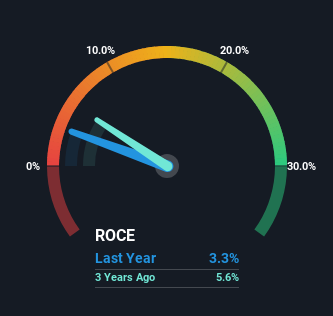- Israel
- /
- Construction
- /
- TASE:SPEN
Some Investors May Be Worried About Shapir Engineering and Industry's (TLV:SPEN) Returns On Capital
Did you know there are some financial metrics that can provide clues of a potential multi-bagger? Amongst other things, we'll want to see two things; firstly, a growing return on capital employed (ROCE) and secondly, an expansion in the company's amount of capital employed. Ultimately, this demonstrates that it's a business that is reinvesting profits at increasing rates of return. Although, when we looked at Shapir Engineering and Industry (TLV:SPEN), it didn't seem to tick all of these boxes.
Return On Capital Employed (ROCE): What Is It?
For those that aren't sure what ROCE is, it measures the amount of pre-tax profits a company can generate from the capital employed in its business. The formula for this calculation on Shapir Engineering and Industry is:
Return on Capital Employed = Earnings Before Interest and Tax (EBIT) ÷ (Total Assets - Current Liabilities)
0.033 = ₪402m ÷ (₪16b - ₪3.4b) (Based on the trailing twelve months to December 2024).
So, Shapir Engineering and Industry has an ROCE of 3.3%. Ultimately, that's a low return and it under-performs the Construction industry average of 7.4%.
View our latest analysis for Shapir Engineering and Industry

While the past is not representative of the future, it can be helpful to know how a company has performed historically, which is why we have this chart above. If you'd like to look at how Shapir Engineering and Industry has performed in the past in other metrics, you can view this free graph of Shapir Engineering and Industry's past earnings, revenue and cash flow.
What Can We Tell From Shapir Engineering and Industry's ROCE Trend?
In terms of Shapir Engineering and Industry's historical ROCE movements, the trend isn't fantastic. Over the last five years, returns on capital have decreased to 3.3% from 8.1% five years ago. On the other hand, the company has been employing more capital without a corresponding improvement in sales in the last year, which could suggest these investments are longer term plays. It may take some time before the company starts to see any change in earnings from these investments.
The Bottom Line
Bringing it all together, while we're somewhat encouraged by Shapir Engineering and Industry's reinvestment in its own business, we're aware that returns are shrinking. Unsurprisingly, the stock has only gained 13% over the last five years, which potentially indicates that investors are accounting for this going forward. So if you're looking for a multi-bagger, the underlying trends indicate you may have better chances elsewhere.
If you'd like to know more about Shapir Engineering and Industry, we've spotted 3 warning signs, and 2 of them make us uncomfortable.
While Shapir Engineering and Industry may not currently earn the highest returns, we've compiled a list of companies that currently earn more than 25% return on equity. Check out this free list here.
New: Manage All Your Stock Portfolios in One Place
We've created the ultimate portfolio companion for stock investors, and it's free.
• Connect an unlimited number of Portfolios and see your total in one currency
• Be alerted to new Warning Signs or Risks via email or mobile
• Track the Fair Value of your stocks
Have feedback on this article? Concerned about the content? Get in touch with us directly. Alternatively, email editorial-team (at) simplywallst.com.
This article by Simply Wall St is general in nature. We provide commentary based on historical data and analyst forecasts only using an unbiased methodology and our articles are not intended to be financial advice. It does not constitute a recommendation to buy or sell any stock, and does not take account of your objectives, or your financial situation. We aim to bring you long-term focused analysis driven by fundamental data. Note that our analysis may not factor in the latest price-sensitive company announcements or qualitative material. Simply Wall St has no position in any stocks mentioned.
About TASE:SPEN
Shapir Engineering and Industry
Engages in the construction, engineering, and infrastructure businesses in Israel.
Acceptable track record with low risk.
Market Insights
Community Narratives



